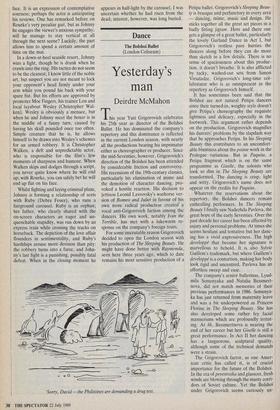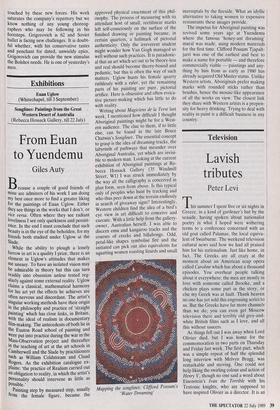Dance
The Bolshoi Ballet (London Coliseum)
Yesterday's man
Deirdre McMahon
This year Yuri Grigorovich celebrates his 25th year as director of the Bolshoi Ballet. He has dominated the company's repertory and this dominance is reflected in the current London season, with nearly all the productions bearing his imprimatur either as choreographer or producer. Since the mid-Seventies, however, Grigorovich's direction of the Bolshoi has been attended by considerable friction and controversy. His recensions of the 19th-century classics, particularly his elimination of mime and the demotion of character dancing, pro- voked a hostile reaction. His decision to jettison Leonid Lavrovsky's warhorse ver- sion of Romeo and Juliet in favour of his own more radical production created a vocal anti-Grigorovich faction among the dancers. His own work, notably Ivan the Terrible, has met with a lukewarm re- sponse on the company's foreign tours.
For some inscrutable reason Grigorovich decided to open the London season with his production of The Sleeping Beauty. He might have done better with Raymonda, seen here three years ago, which to date remains his most sensitive production of a `Sorry, David — the Philistines are demanding a drug test.
Petipa ballet. Grigorovich's Sleeping Beau- ty is brusque and perfunctory in every area — dancing, mime, music and design. He sticks together all the great set pieces in a badly fitting jigsaw, Here and there one gets a glimpse of a great ballet, particularly the lovely Garland Dance in Act I, but Grigorovich's restless pace hurries the dancers along before they can do more than sketch in a few details. There is no sense of spaciousness about this produc- tion, it doesn't breathe. It is also afflicted by tacky, washed-out sets from Simon Virsaladze, Grigorovich's long-time col- laborator who is as omnipresent in the repertory as Grigorovich himself.
It has sometimes been said that the Bolshoi are not natural Petipa dancers since their turned-in, weighty style doesn't give Petipa's choreography the requisite lightness and delicacy, especially in the footwork. This argument rather depends on the production. Grigorovich magnifies his dancers' problems by the slapdash way that he approaches Petipa. In his Sleeping Beauty this contributes to an uncomfort- able bluntness about the pointe work in the Prologue variations. But in Paquita, a Petipa fragment which is on the same programme as Giselle, the soloists who look so dim in The Sleeping Beauty are transformed,. The dancing is crisp, light and witty. Grigorovich's name does not appear on the credits for Paquita.
Whatever the reservations about the repertory, the Bolshoi dancers remain enthralling performers. In The Sleeping Beauty I finally saw Nadezhda Pavlova, the great hope of the early Seventies. Over the past decade her career has.been affected by injury and personal problems. At times she seems hesitant and tentative but her danc- ing has a vivid expressiveness. The high developpe that became her signature is marvellous to behold. It is also Sylvie Guillem's trademark, but where Guillem's developpe is a contortion, making her body look rigid and uncentred, Pavlova has an effortless sweep and ease.
The company's senior ballerinas, Lyud- mila Semenyaka and Natalia Bessmert- nova, did not match memories of their previous performances in 1986. Semenya- ka has just returned from maternity leave and was a bit underpowered as Princess Florine in The Sleeping Beauty. She has also developed some rather fey facial mannerisms which are profoundly irritat- ing. At 48, Bessmertnova is nearing the end of her career but her Giselle is still a great performance. In Act II her dancing has a languorous, sculptural quality, although some of the technical demands were a strain.
The Grigorovich factor, as one Amer- ican critic has called it, is of crucial importance for the future of the Bolshoi. In the era of perestroika and glasnost, fresh winds are blowing through the musty corri- dors of Soviet culture. Yet the Bolshoi under Grigorovich seems curiously un-
touched by these new forces. His work saturates the company's repertory but we know nothing of any young choreog- raphers who may be following in his footsteps. Grigorovich is 62 and Soviet ballet is facing new challenges. It is doubt- ful whether, with his conservative tastes and penchant for dated, unwieldy epics, Grigorovich can provide the new stimulus the Bolshoi needs. He is one of yesterday's men.



















































 Previous page
Previous page